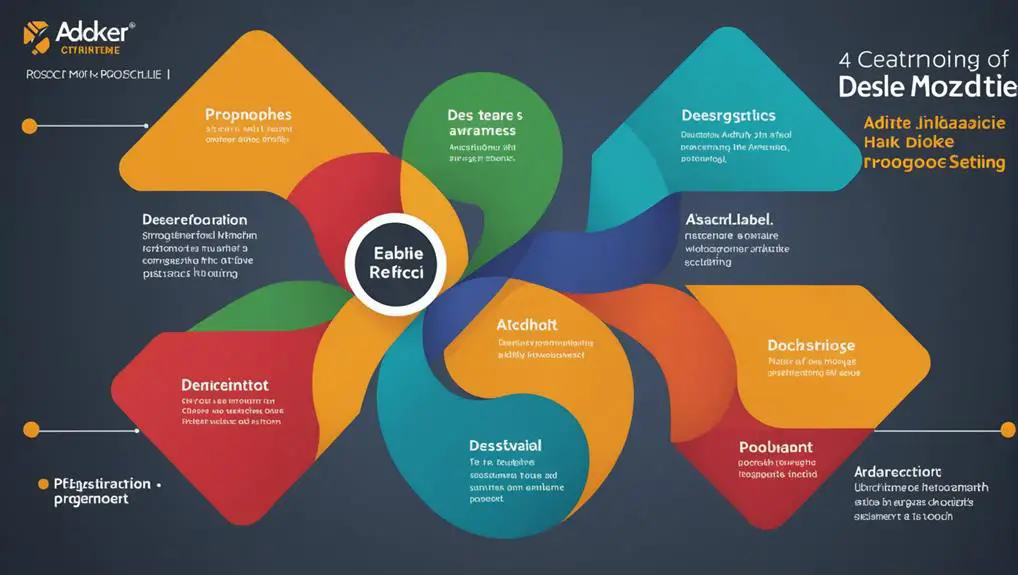So, you’re familiar with the five steps of the ADKAR model. But have you truly grasped their essence? Understanding the significance of each stage is just the beginning of your journey.
Delving deeper into every step and uncovering the nuances that can either make or break your change management efforts is the real test.
Are you ready to explore how each piece contributes to achieving successful organizational change? Let’s break it down and see how each element plays a crucial role.
Key Takeaways
Understanding the why behind change is essential. Without this clarity, progress becomes challenging. Take the time to uncover the reasons for change before diving in.
Building motivation and commitment is crucial once the need for change is established. It’s about gearing up for a significant challenge and fully committing to the process.
Having the right information is key to driving change. Whether it’s data, facts, or advice from experienced individuals, having a clear roadmap is essential.
However, information alone isn’t sufficient. You also need the skills and resources to execute the change effectively. It’s like having a toolbox equipped with everything you need to get the job done.
Feedback is vital for sustaining change in the long run. Whether it’s feedback from others, self-reflection, or progress tracking, it serves as a compass to keep you on track during the change process.
Awareness: Understanding the Need for Change
The Awareness phase in the ADKAR model is critical. Understanding why change is necessary lays the foundation for successful implementation. Communication is key during this phase to ensure everyone is informed and on board with the upcoming changes.
Your role in the awareness phase is pivotal. By comprehending the ‘what’ and ‘why’ of the change process, you can navigate it more effectively. Managers also play a crucial part by helping employees understand the need for change and addressing any resistance. Open and honest communication fosters unity and a common purpose among team members.
Desire: Building Motivation and Commitment
In the Desire phase of the ADKAR model, individuals actively choose to be part of the change process due to understanding the benefits and impacts of the transformation. Building desire among employees is crucial for the success of the change, as it relies on their motivation and dedication.
Managers play a key role in fostering desire by making the change personally relevant to employees, thus encouraging commitment. Personalized communication and support help employees grasp the benefits and commit wholeheartedly to the change.
Knowledge: Equipping With Necessary Information
The Knowledge phase in the ADKAR model focuses on equipping employees with essential information to understand how the changes will impact their roles. Training and clear communication are vital in ensuring employees have a solid understanding before engaging in training sessions.
When employees possess the right knowledge, they feel more prepared to adapt to new ways of working during times of change. Tailoring training to individual job roles ensures employees have the necessary information to excel in their evolving responsibilities.
Ability: Providing Skills and Resources
Moving from understanding the change to implementing it in the ADKAR model requires a targeted approach. Sharpening skills and providing necessary resources are essential for employees to navigate the change effectively.
Support mechanisms like coaching and feedback create a supportive environment for employees to enhance their skills and embrace the transformation. Empowering employees with tools and resources facilitates successful adoption of the change, fostering ongoing growth and contributions to the transformation process.
Reinforcement: Sustaining Change Through Feedback
For change to stick in the ADKAR model, organizations must have robust feedback systems in place. Feedback loops highlight areas for improvement and ensure the change is effective.
Recognizing and rewarding employees for embracing change fosters commitment and creates a culture of continuous improvement. Celebrating wins and milestones showcases the impact of change and reinforces the importance of feedback and recognition in sustaining the transformation.
Feedback systems not only track progress but also provide valuable insights for informed decision-making to support the change journey. Organizations that prioritize feedback and recognition empower employees, driving the success of the change initiative.
Frequently Asked Questions
What Are the 5 Steps of the Adkar Model?
To master the ADKAR Model, remember the 5 steps: Awareness, Desire, Knowledge, Ability, Reinforcement. Embrace each step: communicate about change, ignite excitement, educate, provide tools, and ensure lasting impact. You hold the key to preparing everyone for change and driving organizational success.
What Are the 5 Principles of ADKAR for Change Management?
To excel in change management using ADKAR, familiarize yourself with these 5 principles: Awareness, Desire, Knowledge, Ability, and Reinforcement. Addressing resistance involves engaging individuals, establishing clear communication plans, gaining leadership support, delivering effective training, aligning stakeholders, ensuring readiness, promoting behavior change, fostering cultural shifts, and providing continuous reinforcement.
What Are the 5 R’s of Prosci?
To understand the 5 R’s of Prosci in change management, focus on: Resistance, Reasons, Reinforcement, Results, and Return on Investment. Tackle challenges, comprehend motivations, offer ongoing support, observe outcomes, and ensure value realization. Engage everyone, address resistance, tailor communication, secure leadership backing, and reinforce behaviors for success.
Conclusion
Congratulations on mastering the 5 steps of the ADKAR model by Prosci! This positions you for success in driving organizational changes.
Did you know that 70% of change initiatives fail due to lack of employee engagement? By focusing on awareness, desire, knowledge, ability, and reinforcement, you can ensure the changes you implement are sustainable and lead to success within your organization.
Continue applying these steps to effectively manage change and achieve your desired outcomes.



